England will be hosting the long-awaited 2022 UEFA European Women’s Championship this year, kicking off on July 6th at Old Trafford where the hosts will face Austria. Women’s football has witnessed significant growth in support in recent years and is arguably shining the brightest it’s ever shone. The Euros will be the icing on the cake of a breakthrough season.
The Lionesses arrive at the tournament with high hopes and aspirations. It will be Sarina Wiegman’s first major tournament in charge, having become the first non-British permanent England manager when she took over the team last August. She has guided her team to nine wins, two draws and no losses in her short tenure (an 81.8% win rate), including a record-breaking 20-0 victory over Latvia. England currently top their 2023 Women’s World Cup qualification group, winning all their 8 games and scoring a whopping 68 times without conceding a single goal. (That’s 68-0!)
The Dutch manager steered the Netherlands to glory at the 2017 Euros while finishing as runners-up at the 2019 World Cup. She seems to be transferring her winning DNA to this England side, showcasing the progress being made as the Lionesses were crowned champions of the inaugural Arnold Clark Cup in February, playing the likes of Olympic Champions Canada and one of the world’s most in-form teams, Spain.
In Group A they will face Austria, Norway and Northern Ireland, all of whom are ranked below England in the FIFA rankings. The Lionesses currently rank 8th worldwide and 6th in Europe behind Sweden, France, Germany, Netherlands, and Spain. Given their highly talented squad, boosted by the support from their home nation, the team is expected to top the group and go deep in the competition.
This article will be a tactical analysis preview of England ahead of the Euros this summer in the form of a team scout report. It will be an analysis of the side’s tactics under Wiegman to predict how the Lionesses will set up in the upcoming tournament.
Predicted Starting XI

England announced their 23-player final squad on June 15th.
Former captain Steph Houghton is a big omission from the squad. Having not played a competitive game since January because of ankle and Achilles injuries, she could not prove her fitness to the manager. ‘She’s just not ready to compete’ said Wiegman.
Jordan Nobbs is also a key absentee, with the Arsenal midfielder ruled out for the summer due to a knee injury.
The squad includes Fran Kirby, who has not played since February; she was an unused substitute in Chelsea’s Women’s FA Cup triumph in May, though.
With Houghton absent from the final 23, Arsenal’s Leah Williamson has been named as captain for the tournament.
Under Wiegman, England most prominently set up in a 4-3-3 formation. Mary Earps is expected to start in goal. At the back, the Manchester City trio of Lucy Bronze, Alex Greenwood and Demi Stokes will be joined by Chelsea’s Millie Bright. In midfield, captain Leah Williamson, who can also play in central defence, will line up alongside Bayern Munich’s Georgia Stanway and Keira Walsh in the holding position. Up front, record goal scorer Ellen White will be joined by two of the most exciting players on the planet right now, Beth Mead and Lauren Hemp.

This age chart includes all 28 players in England’s provisional squad. The graphic is separated into youth (aged 24 and under), peak (24 to 30) and experienced (30 and over).
As can be seen, the majority of England’s team are in their peak years. This is especially key at the back, with Bronze, Bright, Greenwood and Stokes all aged between 28 and 30, racking up 261 caps between them. Their experience and know-how will surely give the team a platform to express themselves and play with confidence — as England generally control possession and build up from the back.
Attacking Phase
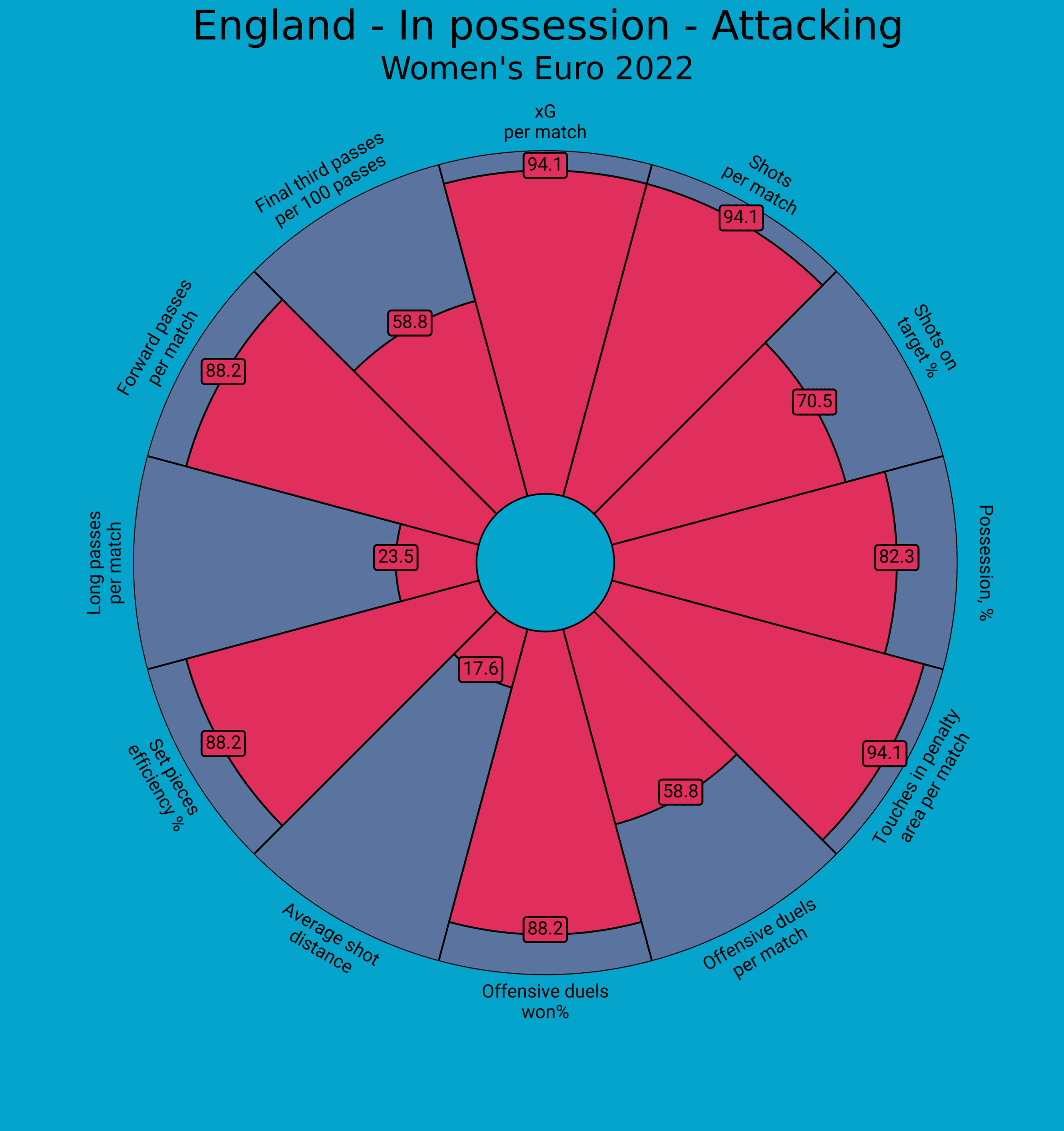
At first glance, what can be deduced from the above graphic is that England are a very attacking outfit. They are in the 94th percentile for xG per match, shots per match and touches in the opposition box. Also, England tend to dominate possession.
Since Wiegman’s arrival, she has focused on introducing key tactical concepts that have made their play more streamlined and productive. This has been helped by the number of players available to her. She has awarded her players’ flexibility on and off the ball, enabling them to make use of the spaces more efficiently. England have been able to keep the ball in the opposition half much more, building momentum and leading to waves and waves of attacks.
In the below image, England are camped in Northern Ireland’s half during the World Cup qualifier back in April. The ball worked its way from the left flank, as can be with the group of players on that side of the pitch, and is now at the feet of Williamson. The skipper, playing at centre-back, has space to drive forward with the ball as the Northern Ireland midfielders had been dragged to the left.
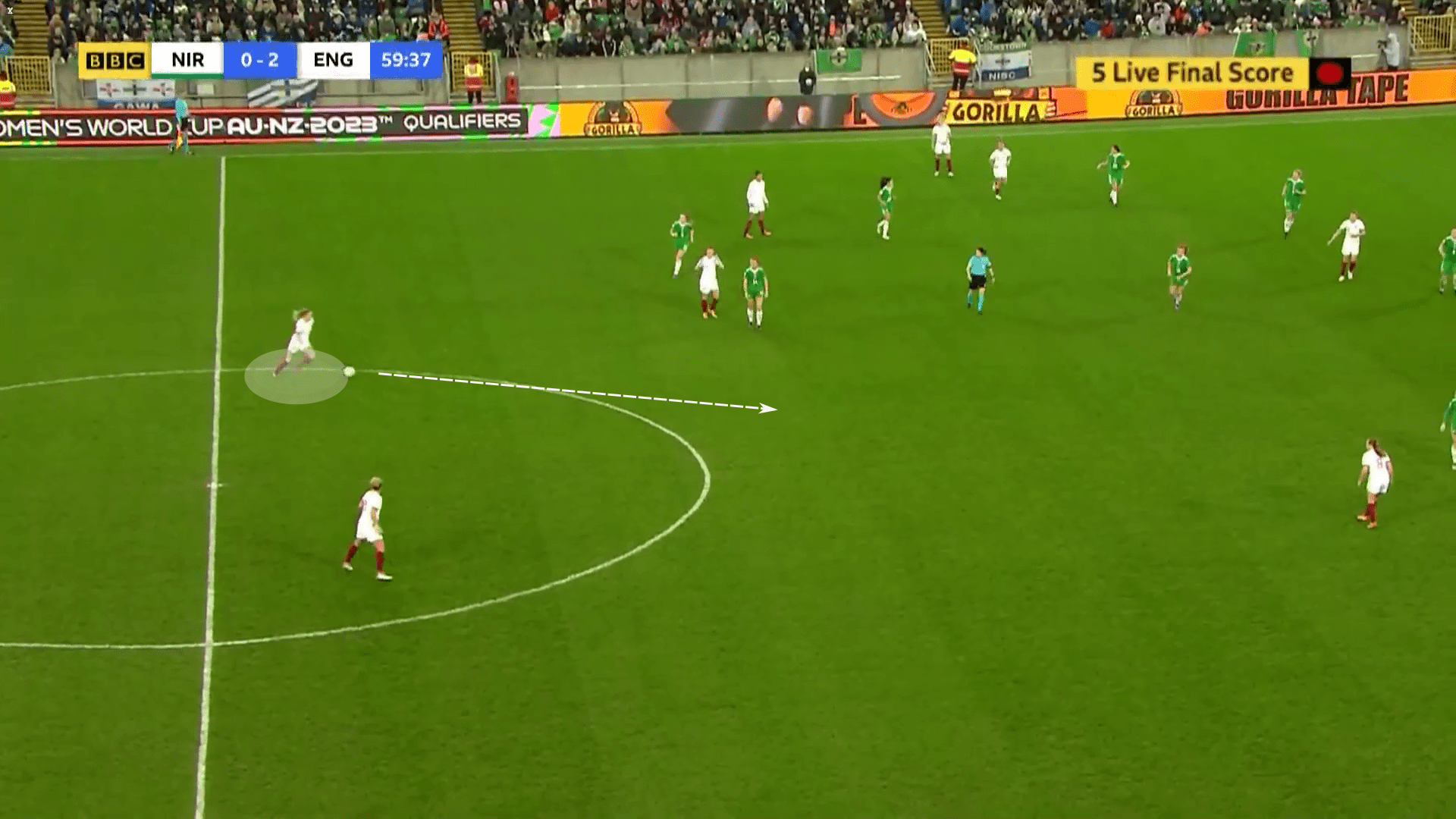
Williamson’s natural vision and quality on the ball allow her to spot the run of Hemp in behind the defenders and slip through a delightful ball to set up Hemp as she rounds the ‘keeper and scores. Hemp’s positioning is interesting here; she drifts into a narrow position and cuts inside from the right channel.
This demonstrates the flexibility of the England side to switch wings — as Hemp naturally plays on the left — and also to play with a narrow front three which gives the full-backs license to push on. One of Wiegman’s tweaks has been to get the wide attackers into more central positions to operate in the middle and half-spaces as they are extremely dangerous in and around the box.
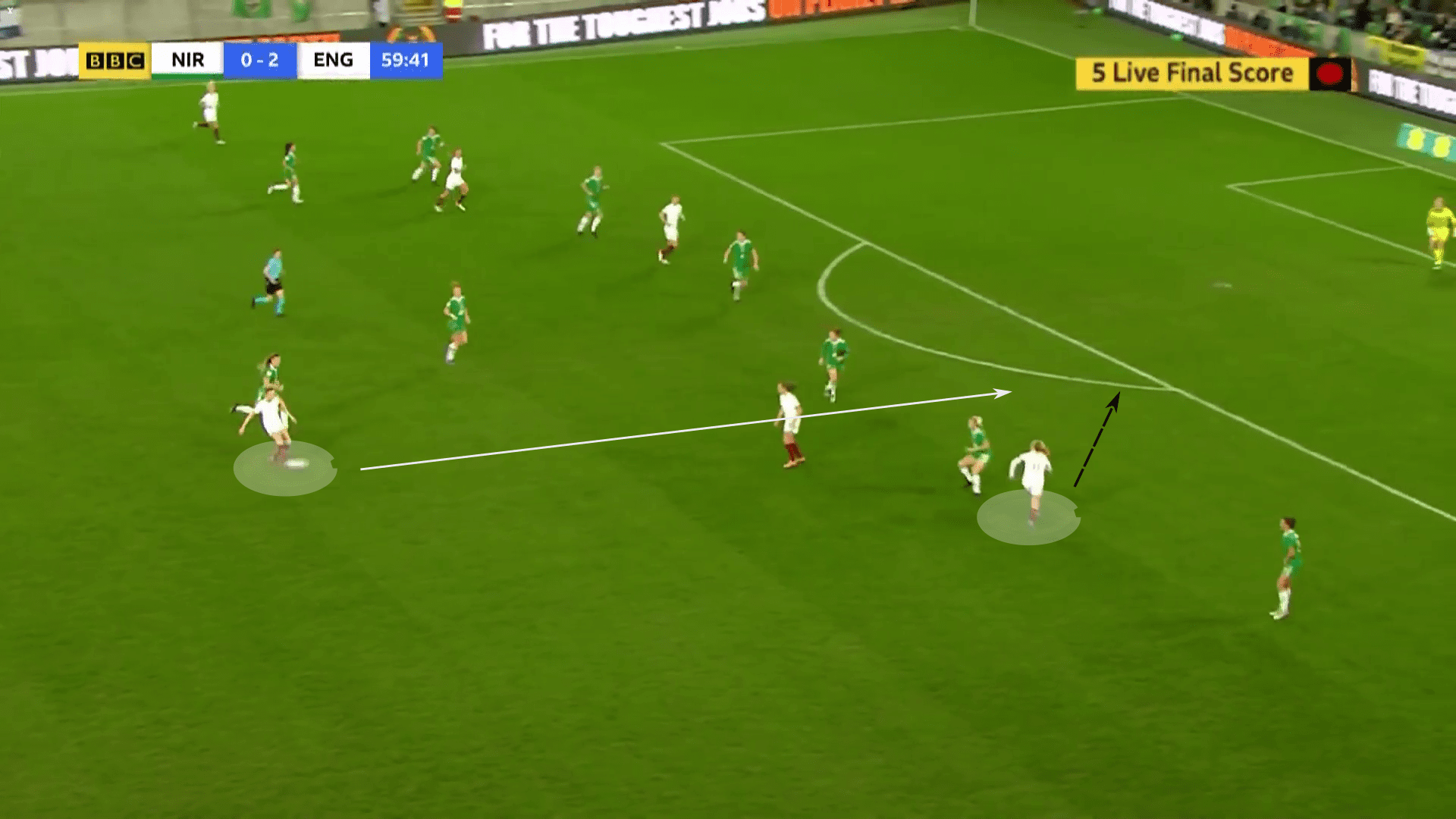
England tend to use the wings as much as possible; their main target is to get the ball to the feet of the electric Hemp and Mead on the flanks. The Lionesses make good use of the wide channels, with the full-backs getting high up the pitch in support. This creates numerical overloads on the wings.
When England face an opponent that successfully closes down the wingers, the ball-sided midfielder will create a triangle with the winger and full-back, sometimes making runs in behind to either drag an opposition player and free up the winger or receive the ball herself.
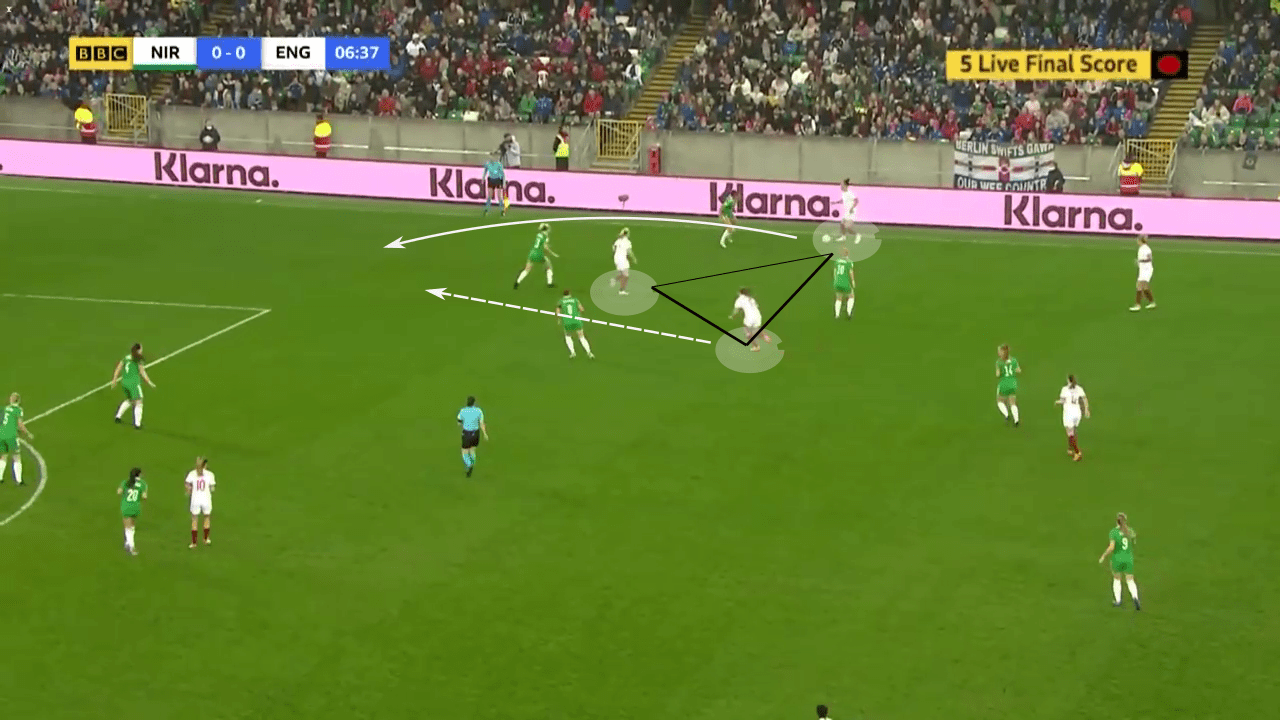
Defensive phase
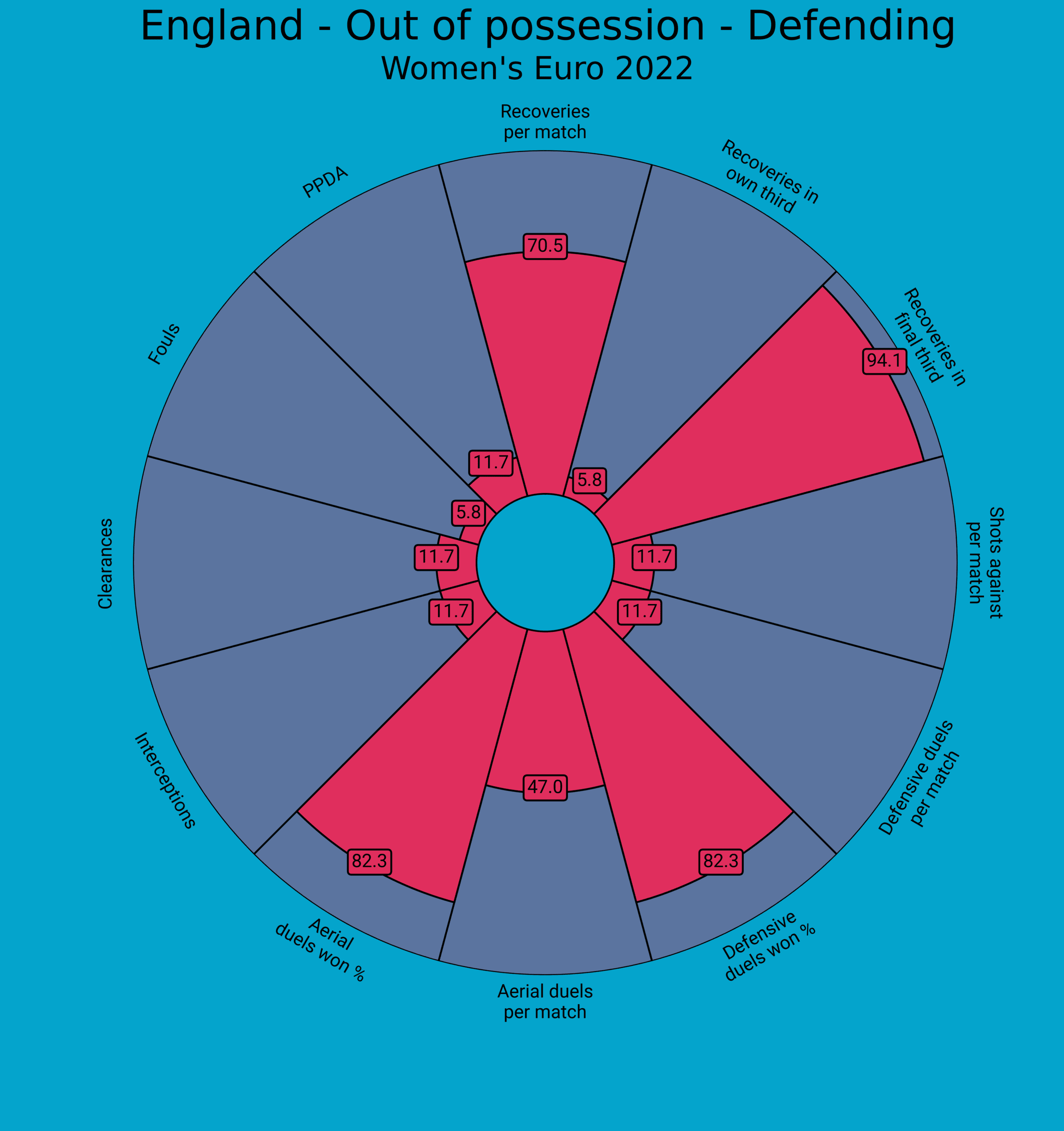
The Lionesses boast a formidable defensive record under Wiegman. They have conceded only two goals in 11 matches since last September. Despite many of these games being against weaker opposition, their ability to keep a clean sheet against a strong Spain side demonstrated England’s defensive solidity.
As seen in the graph above, England can be classified as a pressing machine. They rank in a relatively high percentile for recoveries per match and an extremely high percentile for recoveries in the final third, while also winning a very high number of their defensive duels. Their low PPDA further emphasizes how aggressively the team presses from the front as a unit, closing down spaces and passing lanes to win the ball back quickly high up the pitch and create goal scoring chances.
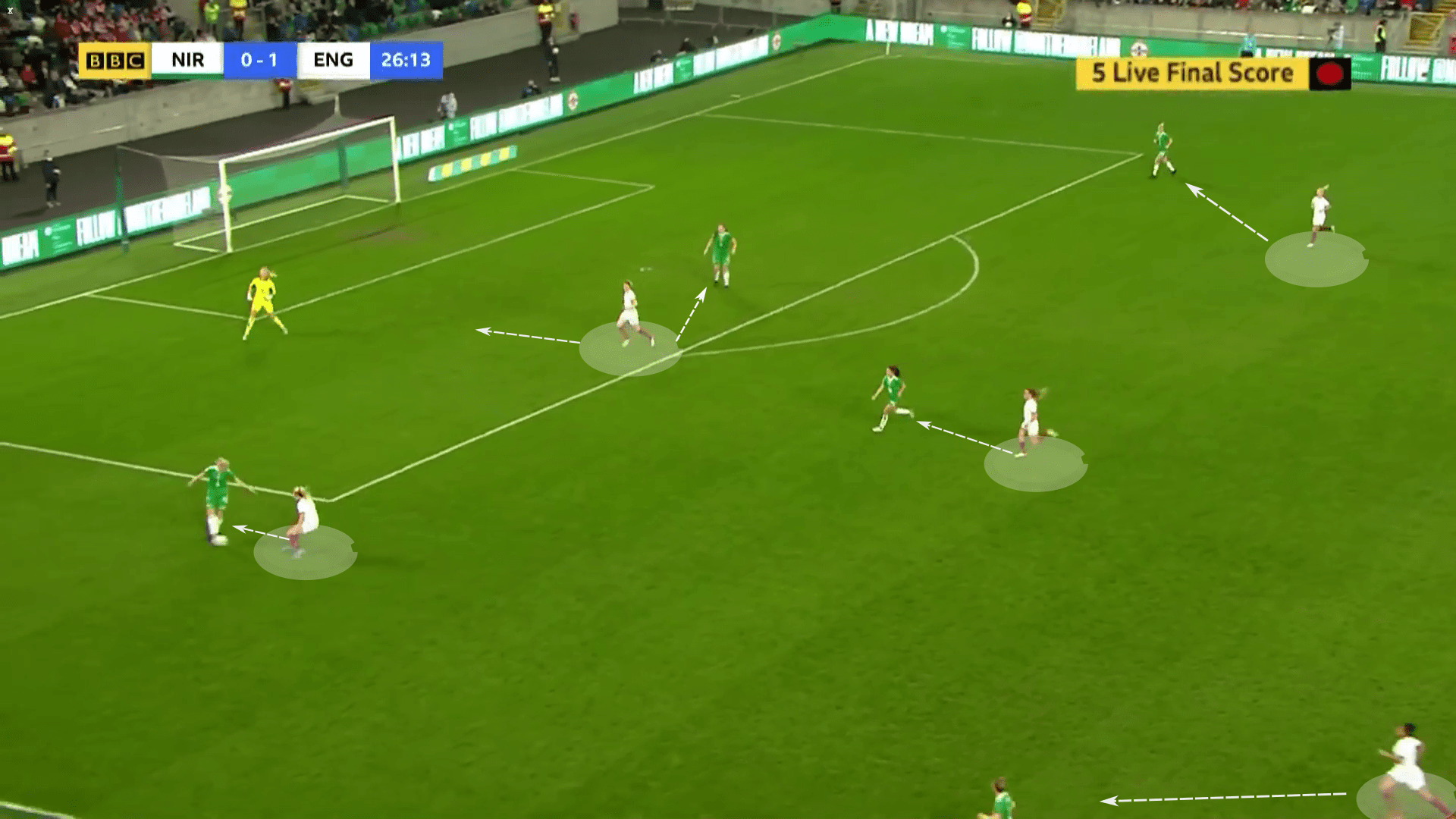
England’s territorial dominance, pressing and desire to always play on the front foot requires the utmost levels of organisation, anticipation and awareness as well as high fitness levels. Naturally, teams that execute these sorts of tactics tend to play with a high defensive line to narrow down the pitch and suffocate their opponents in pressing situations.
In the game versus Spain, we can perfectly spot the team’s high line with the back four situated on the halfway mark. The press is in full flow, Hemp intercepts the pass intended to the centre-back and manages to get a shot off which hits the post. England use Ellen White’s natural instinct of playing on the front foot to apply pressure and dictate the areas to which their opponents pass the ball.
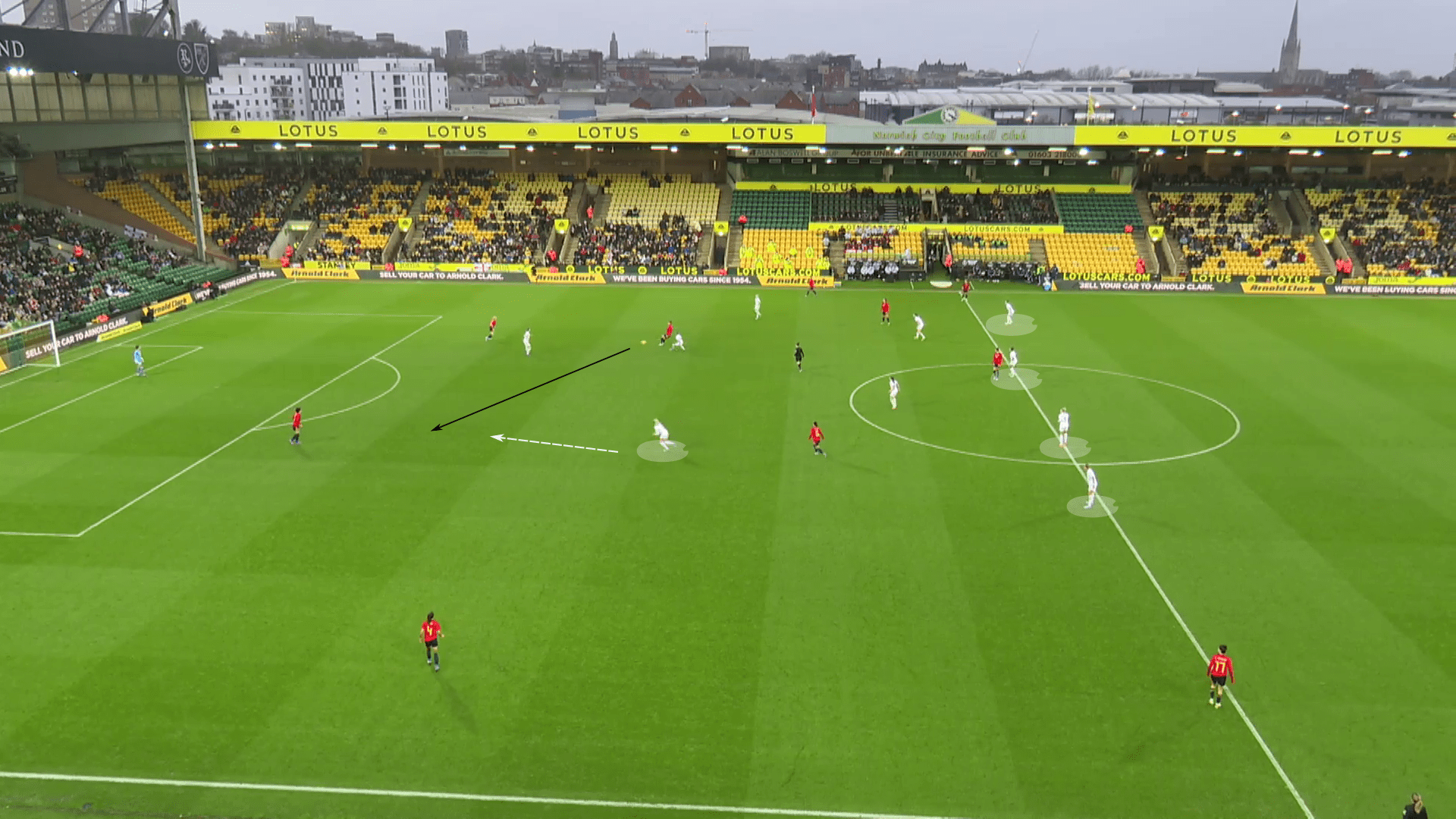
The team is also dominant in the air, winning a relatively high percentage of their aerial duels. Naturally, opposition teams will attempt many balls over the top when facing a high line. The physical presence of Bright, Greenwood and also Williamson is key to England’s aerial dominance and ability to successfully implement this high line while hardly conceding any chances or goals.
Transitions
When England lose the ball in the opponent’s half, they are drilled to counter-press and attempt to win it back high up the pitch — an aspect of the game they are unsurprisingly very successful at based on their recoveries in the final third as previously stated. Note how when the ball is lost below, every England player applies the pressure and cuts the passing lane towards the closest player(s) as well as closing down the ball carrier.
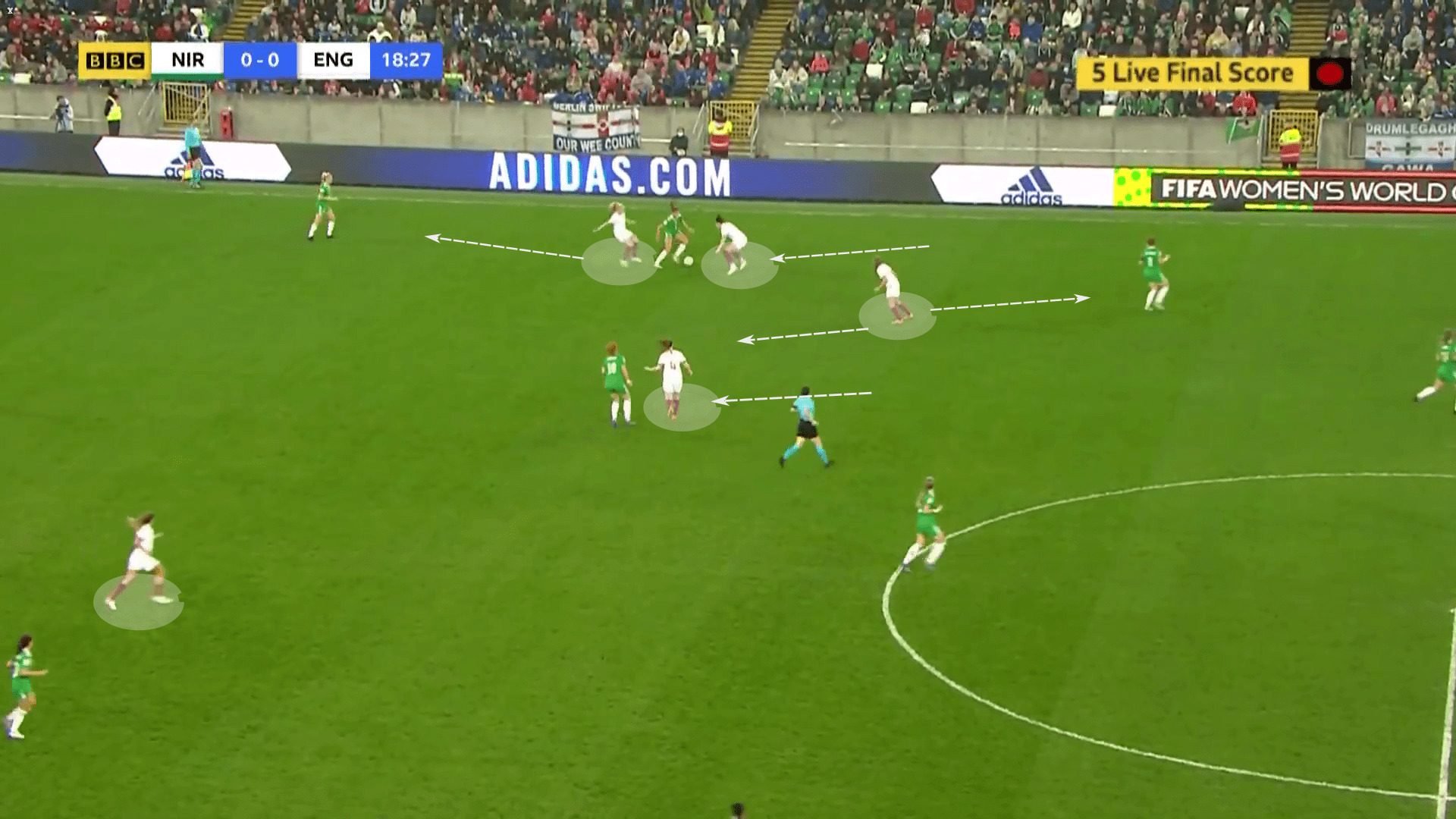
A big factor to succeed in counter-pressing is minimising the spaces between one another when in possession of the ball which can lead the front six to immediately form a compact block after a turnover.
When England win the ball back in their own half, they try to break out quickly and hit their opponents on the counter-attack.
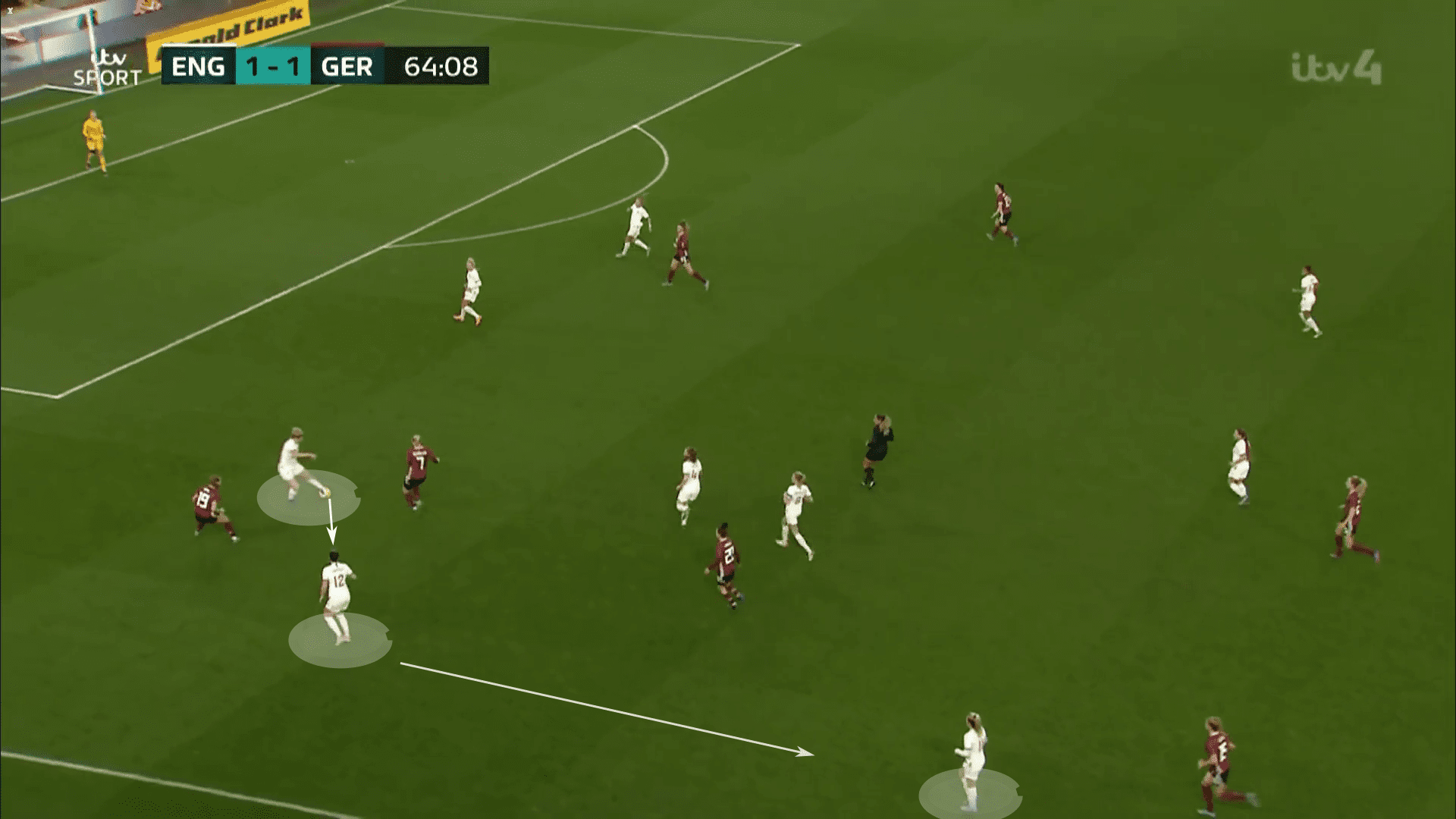
Players will make movements to support the player in possession and give her several passing options to avoid the pressure coming from behind. Notice how in five seconds the ball makes its way from the back to the halfway line and takes out seven German defenders. Beth Mead had three clear passing options to choose from and ended up feeding the ball to the most dangerous area with plenty of space to attack.
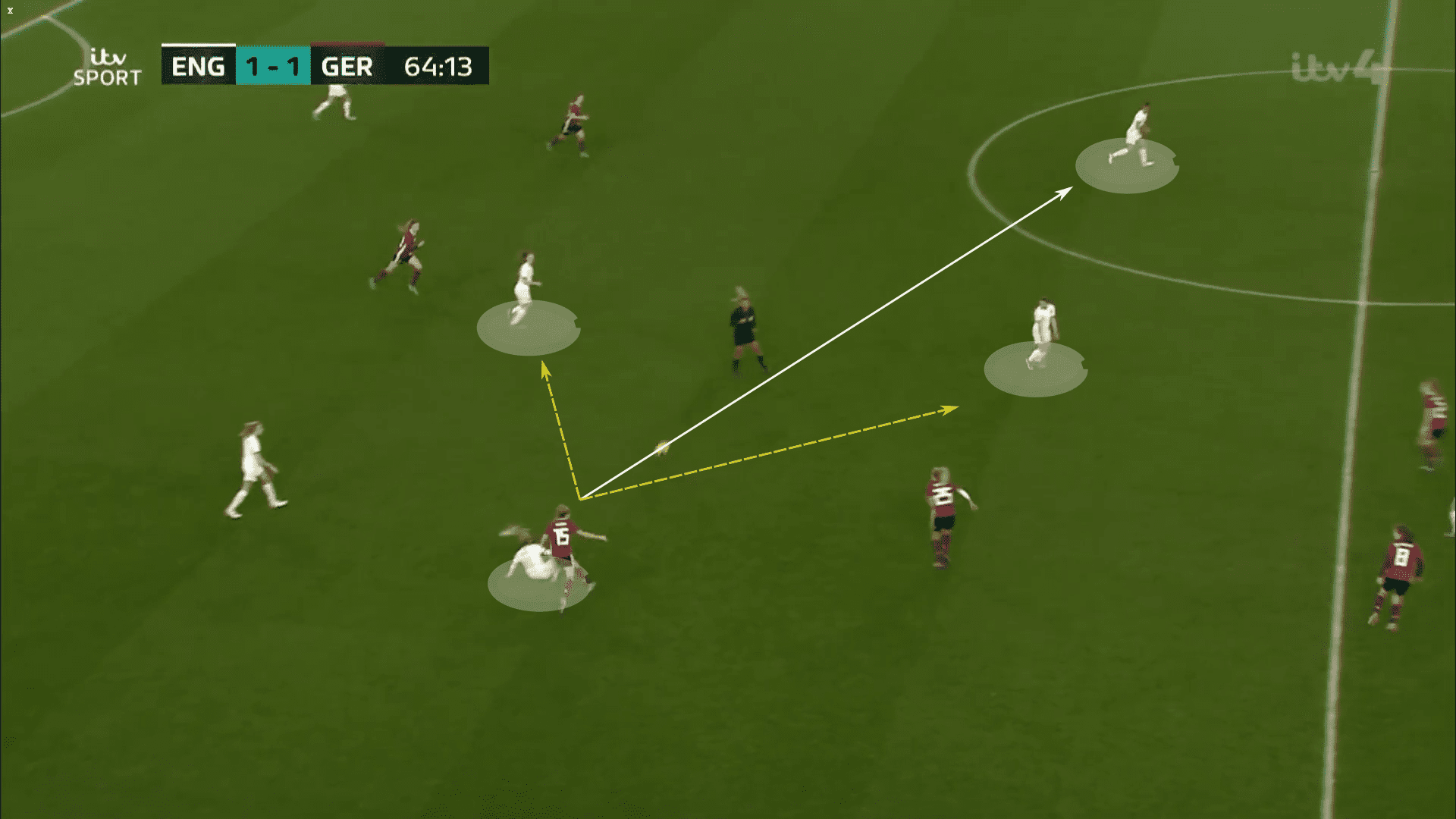
Forwards
As mentioned, England have scored 68 goals in eight World Cup qualifying games, 19 more than the second top scorers, Belgium. The team’s front players have been on fire in front of goal, as well as attacking midfielders Georgia Stanway and Ella Toone. Beth Mead was the second top scorer in the qualifying rounds with 12 goals. Ellen White has chipped in with 10 goals and her experience (106 caps, 50 goals) will be key if England are going to have a chance of winning the tournament. Ella Toone has chipped in with 9 goals, while Georgia Stanway, Lauren Hemp and Beth England have all found the target 6 times.
Chloe Kelly has just returned from an ACL injury but has proved her fitness and earned a spot in the final squad.
One of England’s opponents in the group will be Northern Ireland, a team that the Lionesses have beaten twice in the World Cup qualifiers by an aggregate score of 9-0. England will definitely be going into the Euros with extreme confidence, boasting one of, if not the deadliest strike forces in the world at the moment.
Midfielders
The Lionesses are spoilt for choice in midfield. Under Wiegman, the team has either shaped up in a double pivot in a 4-2-3-1 or with a midfield three in a 4-3-3 formation. Captain Leah Williamson and Manchester City’s Keira Walsh seem like nailed-on starters. Williamson averages 88.4% pass accuracy and 3.89 interceptions per game while Walsh completes 88.9% of her passes and makes 3.24 interceptions per game. Their partnership proved very effective at the Arnold Clark Cup and England will be hoping this continues in the summer.
Wiegman will have a headache regarding the third midfield position. Would Ella Toone or Georgia Stanway be the better attacking midfielder? If she wants to lean towards experience, then we predict that Stanway will get the nod, with 31 caps under her belt to Toone’s 13. Toone is a bigger goal threat, however, scoring 10 goals in only 13 games for the national team.
Fran Kirby is among England’s best midfield players but faces a battle to prove she is ready to start Euro 2022. Kirby has been struggling with fatigue but was part of the Chelsea squad for the FA Cup Final.
At 35 years of age, Jill Scott’s best days are behind her. She has been included in the final 23-player squad but will probably start the majority of Euro 2022 matches on the bench. She is the second most capped player in England women’s history with 156 caps. Her experienced head will be a positive and influential presence around the camp.
Defenders
Former England captain Steph Houghton has missed the majority of the season after struggling with an Achilles injury and has ultimately not made the cut. Millie Bright and Alex Greenwood are stalwarts for England in defence. They are likely to be flanked by Lucy Bronze and Demi Stokes in the full-back positions. As previously mentioned, the four of them share 261 caps between them and are also a goal threat from set-pieces.
Greenwood and Bright will provide a sense of calmness and safety in the build-up phase while their recovery tackles and aerial duels will be key to preventing counter-attacks and not getting caught in their high line. Bright averages 5.31 interceptions and wins around 73.9% of her aerial battles. At full-back, Bronze and Stokes will have a responsibility to bomb forward and support the wingers by making overlapping and underlapping runs, getting into crossing positions and supplying balls towards the strikers. Bronze averages 4.19 dribbles and 3.1 accurate crosses per game.
Best Performer
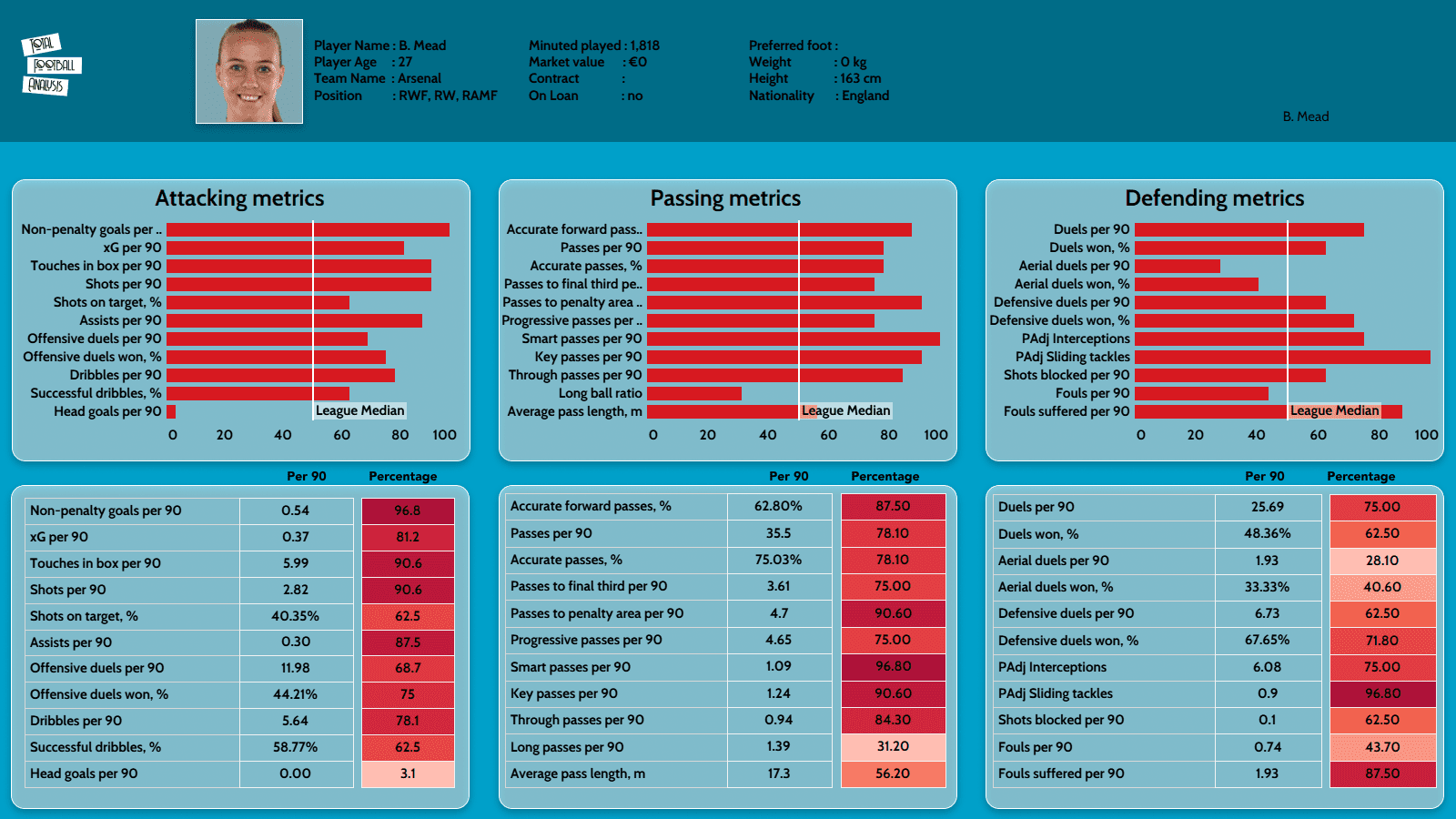
Arsenal’s Beth Mead is tipped for a big Euro 2022 performance. Mead has represented England at every age level from the Under-15s to the senior team. The 27-year-old has scored 20 goals in only 36 caps for her country and has been a key figure in the team since Wiegman’s appointment. She has scored three hat-tricks in the 2023 World Cup qualifiers under the Dutch boss — against Northern Ireland, Latvia and four goals in the 10-0 demolition of North Macedonia.
She can play in either of the wide forward positions and is a dangerous threat; she can get past her defender in 1v1 situations and supply balls towards Ellen White as well as make cutting runs into narrower areas and operate in the half-spaces in and around the box. The forward ranks above the league median in all attacking statistics except for headed goals, which is understandable for a winger; but it is an area that can be improved. With White being the focal point of the team, Mead’s attacking metrics are top-notch, most notably her 0.54 non-penalty goals (ranking in the 96.8 percentile), 5.99 touches in the box and 2.82 shots per 90.
As for her passing metrics, she also ranks above the league median in all but one category — long ball ratio — the reason being that England’s style of play is based on short passes, controlled possession, and unlocking gaps in defences to break them down. That is demonstrated in the smart passes, key passes and passes into the penalty area per 90 metrics which all rank in the 90th+ percentile.
Defensively, the only two areas in which Mead falls below the league median are aerial duels and aerial duels won %, which again highlight that heading the ball is not Mead’s strong suit. England’s aggressive pressing and high-energy defensive structure from the front mean that Mead engages in 25.69 duels (winning 48.36%) and makes 6.08 interceptions per game. She is also one of the most fouled players.
Tournament Prediction
Based on what has been discussed in this tactical analysis and given that England have a favourable group of Norway, Austria and Northern Ireland (ranking 11th, 21st and 46th in the FIFA rankings, respectively), the Lionesses will have huge expectations going into the competition. England have already defeated Austria once and Northern Ireland twice in their World Cup qualifying group. The latter side has never beaten England and haven’t scored a goal against them since 1985.
Sweden, France, Germany, Netherlands, Spain and England sit highest in the FIFA rankings. The bookies fancy Jorge Vilda’s Spain given many of their squad play for Barcelona, the 2022 Champions League finalists, but they only broke into the top ten of FIFA’s rankings in 2021. Meanwhile, Sweden were most recently crowned silver medallists at the Olympics in Tokyo last summer, and have the highest FIFA ranking in the competition, placing second in the world behind the United States. The Netherlands have had the most impressive run in the sport’s major competitions recently, winning Euro 2017 and finishing as runners-up in the 2019 World Cup. However, it will be interesting to see how they fare without now-England boss Sarina Wiegman.
Despite the Lionesses being the lowest-ranked of the European big guns, playing with a home advantage will undoubtedly better their chances in the competition and make them hope and dream of a Euro 2022 triumph in front of their fans, even if their chances of actually achieving success may not match up with the levels of expectation that will be placed upon them.




Comments